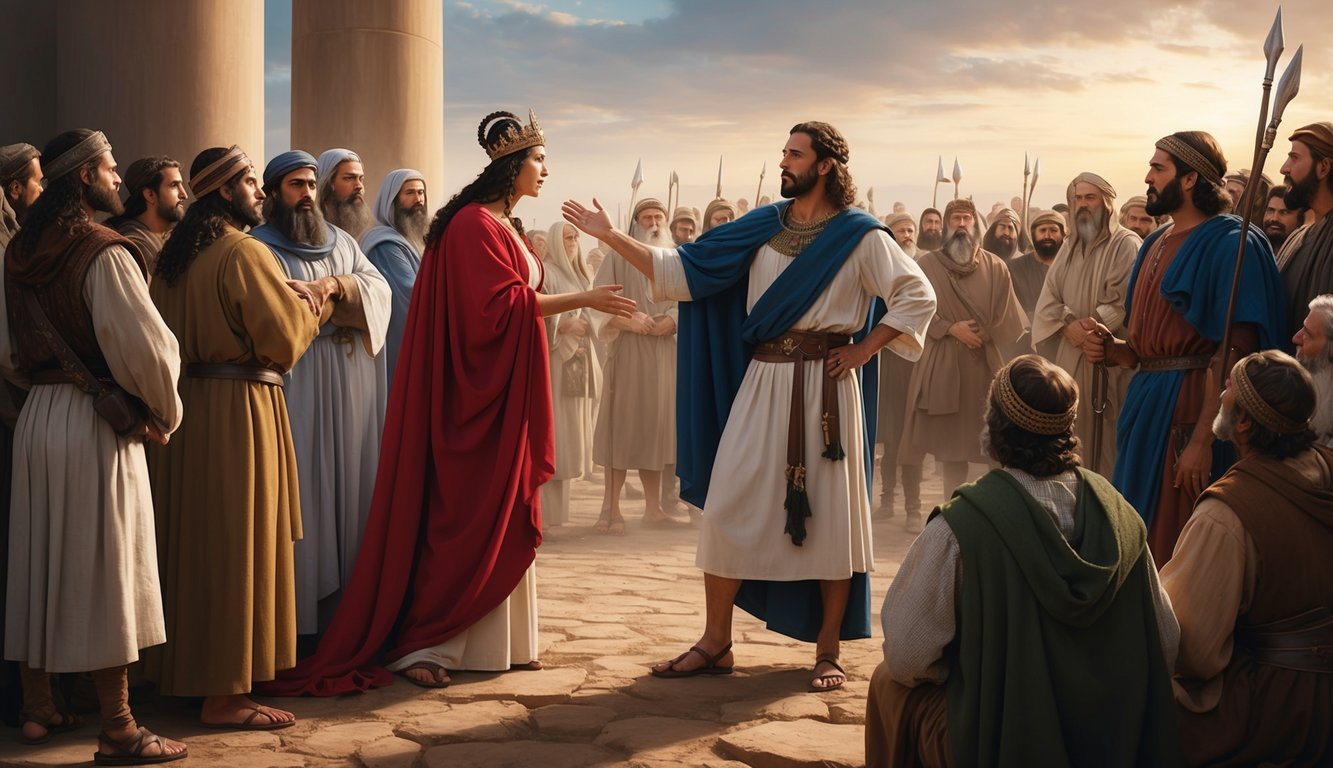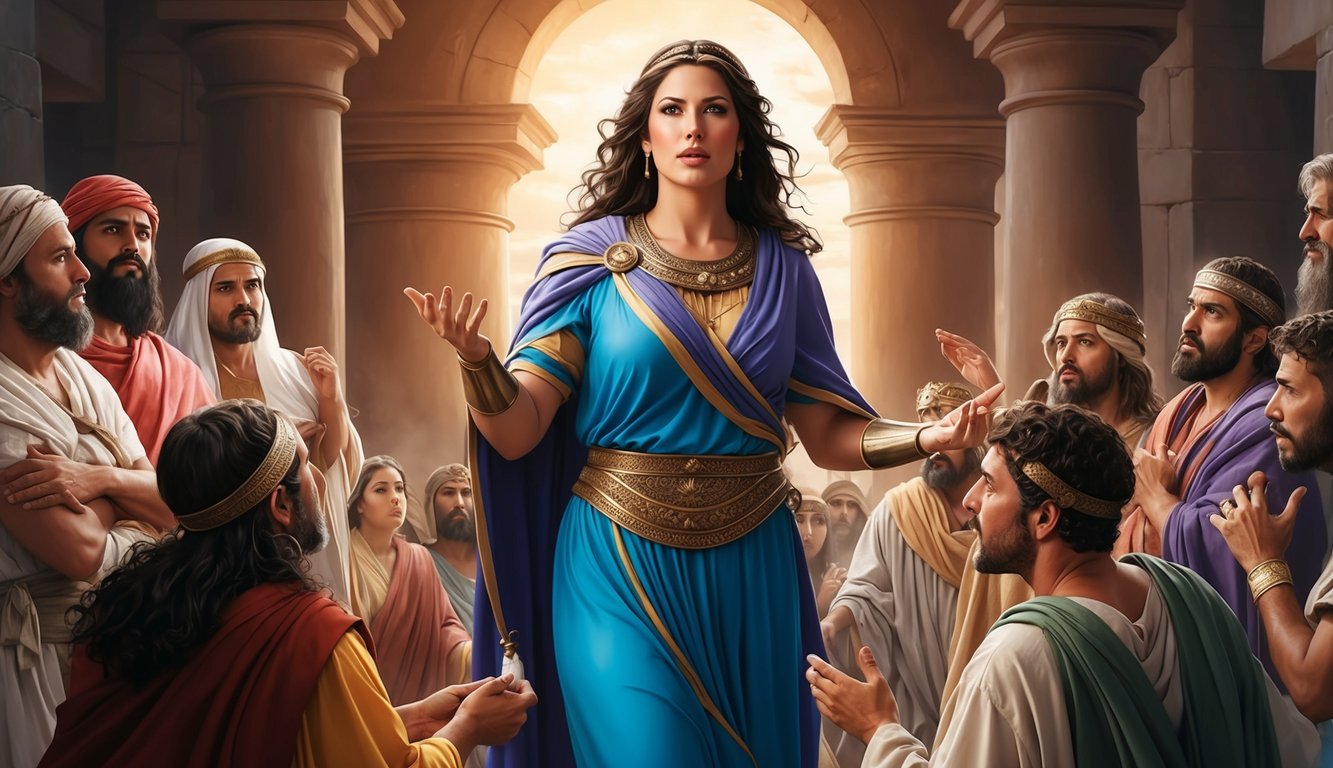Don’t Miss Out On This Unique Astrological Opportunity
Are you tired of spinning your wheels and getting nowhere? Simply put, you’re out of sync: you’re out of alignment with your astral configuration.
But: there’s a kind of map that can help you reclaim your alignment. Think of it as your own personal blueprint to success and happiness: a blueprint that will help you live your most amazing life.
Get started here.
Throughout the Bible, Jezebel is one of the most infamous characters, known for her role as a queen and her association with idolatry.
Jezebel became queen by marrying King Ahab of Israel.
She is often remembered for encouraging the worship of Baal, which led to conflict with the prophets of Yahweh.
Her actions and influence have sparked debates about power, faith, and morality.
Jezebel’s story might seem distant, but it touches on timeless issues such as leadership, religious freedom, and the complexity of human character.
She often appears in discussions as a cautionary tale about the dangers of power misuse.
Her presence in the Bible serves as a powerful reminder of the consequences of straying from one’s beliefs and the struggles faced by those who preach against the tide.
Jezebel’s legacy extends beyond the biblical text into the broader culture, where her name is often used to describe a woman who is manipulative or wicked.
This reputation makes her a fascinating figure, not only in religious texts but also in literature and popular culture.
By exploring Jezebel’s story, you gain insight into the cultural and religious dynamics of ancient Israel.
For more details on Jezebel’s portrayal in different contexts, you can check out discussions on her impact in various historical interpretations.
Historical Context and Background
Jezebel was a Phoenician princess who became the queen of Israel by marrying King Ahab.
She brought her cultural and religious beliefs to the Northern Kingdom of Israel, influencing its political and religious landscape.
The Rise of King Ahab and Queen Jezebel
In the biblical text of 1 Kings, Ahab becomes king of the Northern Kingdom of Israel, ruling over a nation faced with internal and external struggles.
His marriage to Jezebel, a Phoenician princess from Sidon, marked a significant political alliance.
This union aimed at strengthening Israel’s ties with Phoenicia, a powerful maritime empire known for its wealth and trade networks.
Ahab’s reign was marked by prosperity and military strength, but it was also fraught with tension due to Jezebel’s influence on the religious practices in Israel.
Her introduction of worship practices from her heritage clashed with the Hebrew faith, setting the stage for conflict.
Jezebel’s Phoenician Heritage
Jezebel came from Phoenician royalty, as the daughter of Ethbaal, king of Tyre and Sidon.
These cities were major centers in the Mediterranean trade routes, known for their achievements in navigation and commerce. Sidonians, as her people were known, had rich cultural traditions and polytheistic religious practices.
As a Phoenician princess, Jezebel brought these customs and beliefs to Israel.
This included the worship of Baal, a deity associated with storm and fertility.
Her heritage emphasized the influence of Phoenicia over Israel’s religious landscape and highlighted her role in the cultural integration and tensions that followed her marriage to Ahab.
Israel’s Political and Religious Climate
During Ahab and Jezebel’s time, Israel was navigating a complicated political environment.
The kingdom faced threats from neighboring nations while trying to maintain stability within. Phoenician alliances, strengthened through Jezebel, aimed to bolster Israel’s political standing.
However, this came at a cost to the religious traditions that were central to the Hebrew people.
Jezebel’s efforts to promote her religious beliefs led to significant friction with the prophets and followers of Yahweh in Israel.
This period was marked by a critical clash between the Hebrew religious traditions and those introduced by Jezebel.
Her actions often put her at odds with the prophets, leading to a contentious atmosphere around religious practices in the kingdom.
Religious Conflicts and Idolatry
In the Biblical context, idolatry often led to conflicts between different religious groups.
The story of Jezebel highlights the tension between the worship of Yahweh and the rising influence of Baal.
Baal Worship and Hebrew Prophets
Baal worship became prevalent during the reign of King Ahab, partly due to Jezebel’s influence.
Jezebel, who was a follower of Baal, encouraged the construction of temples and altars dedicated to Baal and Asherah.
This endangered the practice of Yahwism, the worship of Yahweh, in Israel.
Hebrew prophets faced significant challenges in maintaining the exclusivity of Yahweh-worship.
The prophets warned against the worship of false gods like Baal and Astarte, urging the Israelites to return to Yahweh.
Yet, Jezebel sought to suppress Yahweh’s prophets, empowering false prophets aligned with Baal.
These actions set the stage for major confrontations between the religious factions.
Elijah’s Challenge and Divine Retribution
Elijah played a crucial role in opposing Baal worship by challenging King Ahab and the prophets of Baal directly.
On Mount Carmel, Elijah proposed a test to prove which deity held true power.
Each side prepared a bull for sacrifice, but only Elijah’s offering was accepted by divine fire, demonstrating Yahweh’s supremacy.
Following this event, Elijah ordered the execution of the false prophets of Baal.
This dramatic event aimed to turn the people of Israel back to Yahweh.
Elijah predicted a drought and later prophesied rain, further confirming Yahweh’s control over nature.
These actions, focused on Mount Carmel, underscored Yahweh’s power against the false gods worshipped in Samaria.
Key Events and Turning Points

In the biblical narrative, the life of Jezebel is filled with significant events that shaped the course of the kingdom.
Two crucial episodes include her role in Naboth’s vineyard incident and the upheaval led by Jehu.
Naboth’s Vineyard and Ahab’s Downfall
Jezebel played a central role in the tragic story of Naboth’s vineyard.
King Ahab desired Naboth’s lush vineyard in Jezreel.
When Naboth refused to sell it, Jezebel devised a plan.
She wrote letters in Ahab’s name, claiming that Naboth had blasphemed against God and the king.
Naboth was falsely accused and swiftly stoned to death.
With Naboth gone, Ahab took possession of the vineyard, but this act stirred divine anger.
The prophet Elijah declared to Ahab that due to this crime, a disaster would fall upon his house, sparking the beginning of his downfall.
Jezebel’s manipulation led to consequences that illustrated the moral complexities of using power for corrupt purposes.
The Jehu Revolution
The Jehu revolution marked another turning point involving Jezebel.
Jehu, known for his military prowess and divine mission, was anointed by the prophet Elisha to end the house of Ahab.
Jehu marched to Jezreel, where he confronted Jezebel.
Understanding her impending doom, Jezebel attempted to maintain her regal dignity, but her empire crumbled around her.
Under Jehu’s orders, Jezebel was thrown from a window, resulting in her death.
This event symbolized divine retribution and a pivotal shift in the region.
Jehu’s rise led to a change in leadership and the eradication of idolatry from Israel, cementing his alliance with Judah and reshaping the region’s political landscape.
Jezebel’s Defeat and Legacy

In the Bible, Jezebel is infamous for her defiance and tragic end.
Her story is marked by her dramatic fall from power and the complex legacy she left behind.
You’ll learn how her actions shaped biblical interpretations and cultural perceptions over time.
The Fall of Jezebel
Jezebel’s downfall began when King Jehu set out to eliminate her influence.
She was defiant to the end, painting her eyes and adorning her hair in her final defiance.
Her dramatic death occurred when Jehu commanded eunuchs to throw her down from her window.
Once she hit the ground, her body was largely consumed by dogs, leaving almost nothing behind except a few bones, fulfilling the prophetic curse spoken earlier.
Her demise was symbolic, highlighting the consequences of her greed, idolatry, and defiance against God.
Jezebel’s flesh became food for dogs, making her a figure of shame and defeat.
Her daughter, Athaliah, was left as a successor but met her own terrible end.
Cultural Perceptions and Biblical Interpretations
Jezebel’s legacy is complex and multifaceted.
Many view her as a wicked woman who led people into idolatry and sexual immorality.
Her name has become synonymous with promiscuity and falsehood.
She heavily promoted the worship of the Baals, which stood in stark contrast to the worship of Yahweh.
In Revelation, Jezebel is used as a metaphor for corruption and temptation in the church of Thyatira.
This allusion underscores how her image has been used throughout history to symbolize moral and spiritual decay.
Her name still evokes strong feelings, showing how her story deeply penetrated cultural and religious narratives.
Jezebel is often remembered for the ruthless way she wielded power and the consequences of her ambitions.
Cultural and Historical Impact

The story of Jezebel in the Bible has impacted both modern culture and various forms of creative work like art and literature.
Her representation often relates to themes of power, idolatry, and the clash between different beliefs.
Many view her character as a symbol of defiance and influence, making her a subject of fascination in historical and religious discussions.
References to Jezebel appear in music, film, and literature, often depicting her as a figure of caution or empowerment.
Similarly, exploring the St Anne prayer meaning helps believers understand themes of devotion and guidance, much like how Jezebel’s story prompts reflection on faith and morality.
Jezebel’s Influence on Modern Culture
Jezebel, a queen married to King Ahab, is often remembered for her association with idolatry and the worship of Baal.
Her influence can be seen in modern discussions about the misuse of power.
Jezebel is sometimes used as a symbol of defiance and resistance against established norms.
In contemporary culture, the name “Jezebel” has been used to describe women perceived as bold or unconventional.
This use touches on themes of gender and power dynamics.
Many challenge her negative portrayal, suggesting that understanding her historical context might reveal a different perspective on her actions.
Interpretations of Jezebel in Art and Literature
Artists and writers have interpreted Jezebel’s story in various ways.
In art, she appears in paintings and sculptures that explore themes of power and betrayal.
These works often highlight her complex role in her marriage to Ahab and her opposition to Elijah, a prophet who condemned her worship of Baal.
Literature frequently revisits Jezebel as a character who challenges societal roles.
Some texts emphasize her as a figure of power, exploring how her story fits into larger narratives about women and authority.
This has led to diverse portrayals, from villainous to misunderstood, reflecting her enduring intrigue in cultural discourse.
Many scholars and artists seek to reclaim her story, presenting her as a nuanced figure rather than a flat stereotype.
This ongoing conversation shows Jezebel’s lasting imprint on both historical and modern perspectives.



